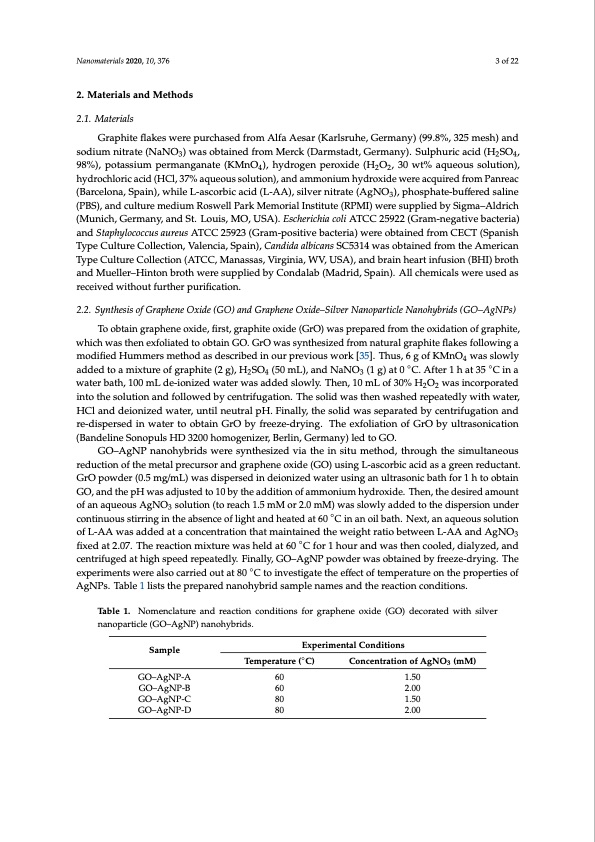
PDF Publication Title:
Text from PDF Page: 003
Nanomaterials 2020, 10, 376 3 of 22 2. Materials and Methods 2.1. Materials Graphite flakes were purchased from Alfa Aesar (Karlsruhe, Germany) (99.8%, 325 mesh) and sodium nitrate (NaNO3) was obtained from Merck (Darmstadt, Germany). Sulphuric acid (H2SO4, 98%), potassium permanganate (KMnO4), hydrogen peroxide (H2O2, 30 wt% aqueous solution), hydrochloric acid (HCl, 37% aqueous solution), and ammonium hydroxide were acquired from Panreac (Barcelona, Spain), while L-ascorbic acid (L-AA), silver nitrate (AgNO3), phosphate-buffered saline (PBS), and culture medium Roswell Park Memorial Institute (RPMI) were supplied by Sigma–Aldrich (Munich, Germany, and St. Louis, MO, USA). Escherichia coli ATCC 25922 (Gram-negative bacteria) and Staphylococcus aureus ATCC 25923 (Gram-positive bacteria) were obtained from CECT (Spanish Type Culture Collection, Valencia, Spain), Candida albicans SC5314 was obtained from the American Type Culture Collection (ATCC, Manassas, Virginia, WV, USA), and brain heart infusion (BHI) broth and Mueller–Hinton broth were supplied by Condalab (Madrid, Spain). All chemicals were used as received without further purification. 2.2. Synthesis of Graphene Oxide (GO) and Graphene Oxide–Silver Nanoparticle Nanohybrids (GO–AgNPs) To obtain graphene oxide, first, graphite oxide (GrO) was prepared from the oxidation of graphite, which was then exfoliated to obtain GO. GrO was synthesized from natural graphite flakes following a modified Hummers method as described in our previous work [35]. Thus, 6 g of KMnO4 was slowly addedtoamixtureofgraphite(2g),H2SO4 (50mL),andNaNO3 (1g)at0◦C.After1hat35◦Cina water bath, 100 mL de-ionized water was added slowly. Then, 10 mL of 30% H2O2 was incorporated into the solution and followed by centrifugation. The solid was then washed repeatedly with water, HCl and deionized water, until neutral pH. Finally, the solid was separated by centrifugation and re-dispersed in water to obtain GrO by freeze-drying. The exfoliation of GrO by ultrasonication (Bandeline Sonopuls HD 3200 homogenizer, Berlin, Germany) led to GO. GO–AgNP nanohybrids were synthesized via the in situ method, through the simultaneous reduction of the metal precursor and graphene oxide (GO) using L-ascorbic acid as a green reductant. GrO powder (0.5 mg/mL) was dispersed in deionized water using an ultrasonic bath for 1 h to obtain GO, and the pH was adjusted to 10 by the addition of ammonium hydroxide. Then, the desired amount of an aqueous AgNO3 solution (to reach 1.5 mM or 2.0 mM) was slowly added to the dispersion under continuous stirring in the absence of light and heated at 60 ◦C in an oil bath. Next, an aqueous solution of L-AA was added at a concentration that maintained the weight ratio between L-AA and AgNO3 fixed at 2.07. The reaction mixture was held at 60 ◦C for 1 hour and was then cooled, dialyzed, and centrifuged at high speed repeatedly. Finally, GO–AgNP powder was obtained by freeze-drying. The experiments were also carried out at 80 ◦C to investigate the effect of temperature on the properties of AgNPs. Table 1 lists the prepared nanohybrid sample names and the reaction conditions. Table 1. Nomenclature and reaction conditions for graphene oxide (GO) decorated with silver nanoparticle (GO–AgNP) nanohybrids. Sample GO–AgNP-A GO–AgNP-B GO–AgNP-C GO–AgNP-D Experimental Conditions Temperature (◦C) 60 60 80 80 Concentration of AgNO3 (mM) 1.50 2.00 1.50 2.00PDF Image | Graphene Oxide–Silver Nanoparticle Nanohybrids

PDF Search Title:
Graphene Oxide–Silver Nanoparticle NanohybridsOriginal File Name Searched:
nanomaterials-10-00376.pdfDIY PDF Search: Google It | Yahoo | Bing
Turbine and System Plans CAD CAM: Special for this month, any plans are $10,000 for complete Cad/Cam blueprints. License is for one build. Try before you buy a production license. More Info
Waste Heat Power Technology: Organic Rankine Cycle uses waste heat to make electricity, shaft horsepower and cooling. More Info
All Turbine and System Products: Infinity Turbine ORD systems, turbine generator sets, build plans and more to use your waste heat from 30C to 100C. More Info
CO2 Phase Change Demonstrator: CO2 goes supercritical at 30 C. This is a experimental platform which you can use to demonstrate phase change with low heat. Includes integration area for small CO2 turbine, static generator, and more. This can also be used for a GTL Gas to Liquids experimental platform. More Info
Introducing the Infinity Turbine Products Infinity Turbine develops and builds systems for making power from waste heat. It also is working on innovative strategies for storing, making, and deploying energy. More Info
Need Strategy? Use our Consulting and analyst services Infinity Turbine LLC is pleased to announce its consulting and analyst services. We have worked in the renewable energy industry as a researcher, developing sales and markets, along with may inventions and innovations. More Info
Made in USA with Global Energy Millennial Web Engine These pages were made with the Global Energy Web PDF Engine using Filemaker (Claris) software.
Infinity Turbine Developing Spinning Disc Reactor SDR or Spinning Disc Reactors reduce processing time for liquid production of Silver Nanoparticles.
| CONTACT TEL: 608-238-6001 Email: greg@infinityturbine.com | RSS | AMP |